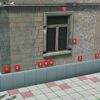Thanks to its large inner surface, a layer of dirt is an excellent absorber of moisture and gaseous and particulate-based pollutants. These usually react to the underside of the incrustation and accelerate destruction.
From historical buildings to private homes
In contrast to bricks or modern building materials, natural stone not only differs with respect to its shape, colour and surface quality, the physical and chemical properties are also very different. It is therefore especially important to preserve the original material and carefully select the newly installed repair materials to preserve the substance for the long-term. Across the world, Remmers stone strengtheners are used to secure historically valuable cultural assets.
Is there anything more beautiful than old ‘masonry’ made of limestone or sandstone? Today, houses are no longer made of natural stone because they would be more expensive than ‘modern’ building materials, which is why it is important to maintain existing buildings made of natural stone.

Work steps
1 Physical strengthening of masonry work
To improve the structural stability and/or load-bearing capacity of hollow and loose masonry, the hollow spaces are filled with BSP 3/6 or BSP Historic in a low-pressure method (acc. to WTA information sheet 4-3-98-D).
2 Cleaning & desalination
Cleaning is not just necessary for the sake of the appearance: Dirt stores moisture and pollutants and prevents the subsurface drying out. Salts are removed close to the surface using Remmers desalination compresses. The compress is applied like a render and removed again with the salts that have penetrated after about 3 weeks.
3 Removal of the joint mortar
Almost all repairs of visible stone façades involves replacing the pointing that is also usually damaged. Usually, the joints need to be dug out 2 cm deep and/or up to twice the width of the joint.
4 Swelling reduction
The hygric swelling and shrinking caused by swellable clay minerals (earthy odour when the stone is moisture) is a frequent source of damage for a number of natural stone types. The swelling extent and speed can be reduced by treating stones with the swelling reduction agent Remmers Antihygro - the only product of its kind on the market at this time.
Desalination of natural stone and other mineral building materials with compresses is a recognised procedure that has proven expedient on many buildings to significantly reduce the amount of structurally damaging salts in buildings.
Masonry work has tradition. In the past, brickwork was built by craftsmen and women; the stone format and wall thickness depend on the estimated loads. Today, information about the load bearing capacity is very important for securing and modifying old building substance.
Lots of natural stones contain clay minerals that can swell. These are usually phyllosilicates whose structure is similar to that of a book. Even when there is little moisture, their electrochemical effect means that they are able to store and also discharge water in their intermediate layers.
The structure of mineral building materials that are exposed to the weather is always weakened. The central task of a consolidation measure is to specifically fill the pore spaces created as a result of the weathering.
The Remmers Restoration Mortar system was specially developed for supplementing mineral building materials or replacing these materials.
Joints in buildings assume a number of functions and therefore need to demonstrate a number of different properties to meet the respective requirements.
For preventive and sustainable protection against moss, fungi and algae, a liquid protective layer against green deposits can be applied before hydrophobing or paint. It forms a protective layer on the substrate, which only becomes active when there is damage.
Remmers graffiti protection belongs to the class of semi-permanent graffiti protection systems. Graffiti and paint smears can be removed from treated surfaces easily thanks to the use of a high pressure water jet equipment.
Water plays a central role in the weathering of mineral building materials. One sensible (precautionary) measure to prevent damage is hydrophobization.
As an alternative to a hydrophobic impregnation, the façade can also be made water-repellent through a covering or transparent silicone resin paint.
Natural stone facades
6 products foundView:
Article No. 067105
Surfactant solution for removing grime, dirt incrustation, dust, oil and grease deposits












![Clean AC [basic] Clean AC [basic]](https://m.remmers.com/gebindeabbildungen/2400w/173507.png?version=0&w=100)



